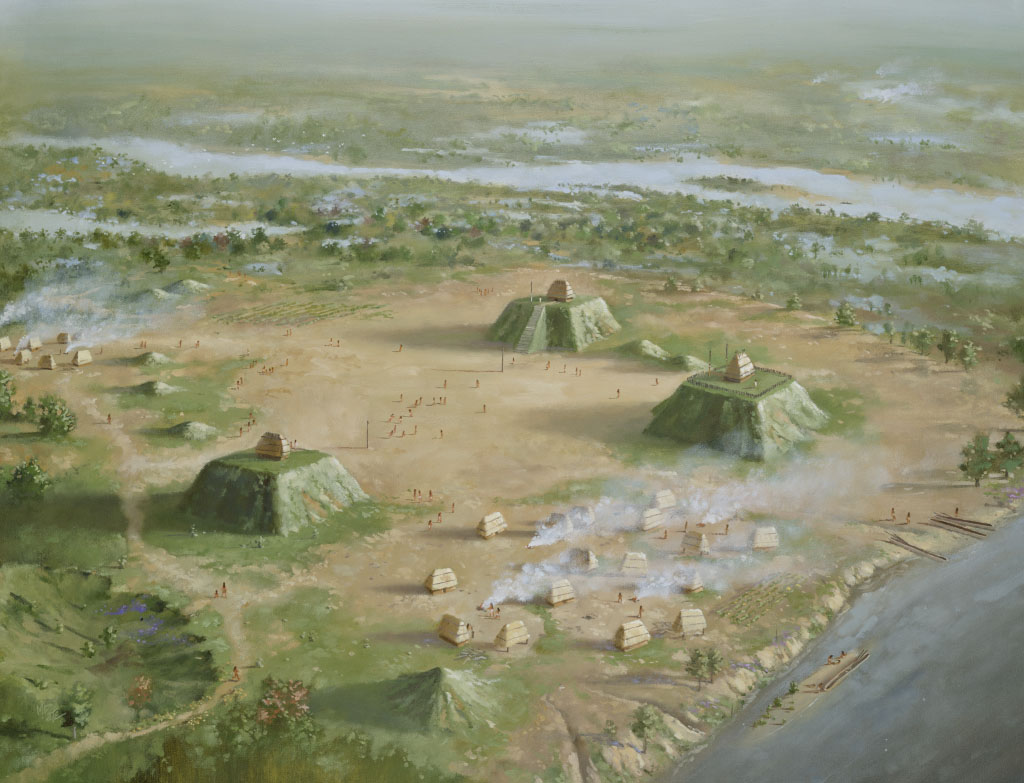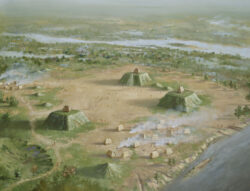Coles Creek Culture
Once covering most of Louisiana, the Coles Creek culture is known for its distinctive ceremonial mound sites.

Martin Pate
Artist Martin Pate’s conception of Pritchard Landing, a Coles Creek period site in Catahoula Parish.
The term “Coles Creek” is applied to a culture that existed in the Lower Mississippi River Valley during the Late Woodland period from 700 to 1200 CE. Building on the developments of the Troyville culture, populations continued to rise. This is reflected in the increase in the number of sites occupied by this culture—more than any other culture in Louisiana at any time. At its greatest extent, Coles Creek culture covered most of Louisiana, the western half of Mississippi to a point just north of the modern town of Greenville, plus a portion of southeastern Arkansas. Notably, Coles Creek peoples moved in great numbers into the recently formed delta lands along the Gulf Coast.
Coles Creek sites are also easy to recognize. Mound sites have a distinctive ceremonial site plan shared throughout their range, indicating considerable communication among Coles Creek peoples over a broad area; Coles Creek peoples also adopted a different kind of pottery decoration with clear ties along the northern Gulf Coast to the panhandle of Florida. In some parts of Louisiana, by late Coles Creek times, sites grew much larger and a hereditary elite emerged.
Coles Creek Culture: Definition and Important Sites
Archaeologists named the Coles Creek culture after a creek that runs by a site in Jefferson County, Mississippi, during excavations in the 1930s. The Coles Creek culture is partially defined by their distinctive ceremonial sites. During early and middle Coles Creek times, these sites had flat-topped mounds placed at each of the cardinal directions. The mounds defined a central plaza, which was probably used for ritual as well as for games (which were steeped in religious significance). A classic example of this configuration can be found at the Balmoral site in Tensas Parish, which was bisected years ago by the construction of US Route 65. Anyone driving on the highway a few miles north of Newellton passes directly through the plaza of the site.
Many mound centers, like the important Greenhouse site in Avoyelles Parish, were built over earlier, circular or oval Troyville culture habitation sites. The Coles Creek site plan conforms to the footprint of the earlier occupation. However, during early and middle Coles Creek culture times, most ceremonial sites were not inhabited. Instead, they were vacant ceremonial centers, without a permanent population (except possibly a presiding lineage and caretaker crew). Most people lived in small, family-based hamlets, fishing, hunting, and gathering, much as their ancestors had in the past. Periodically, people thronged to the ceremonial centers for community-wide religious, feasting, and mortuary rites. Although there is some evidence for flat-topped mounds in the lower Southeast prior to the Coles Creek culture, it was not until Coles Creek times that such mounds became commonplace. Many of these early Coles Creek mounds likely supported some type of structure (possibly the residence of one of the leaders of the society or the ceremonial center’s temple), although it is also possible that some flat-topped mounds served as platforms upon which ceremonies were performed, as opposed to supporting a building. The mound’s height may have allowed a large number of people to witness the events taking place on its summit.
By the middle of Coles Creek culture, there were changes in the sizes of mound sites and the number of mounds at such sites. Larger, regional centers first made their appearance at that time, when it is also likely that the pace and degree of cultural change increased dramatically. Populations grew significantly, as did site size (both mound and non-mound sites) and complexity. The standard, earlier Coles Creek ceremonial site plan of three mounds was expanded, with up to six more mounds added at some sites. The Raffman site, in Madison Parish, had twelve mounds. Compared to early Coles Creek, the number of late Coles Creek sites doubled in northern Louisiana, and Coles Creek peoples expanded into coastal Louisiana as recently formed delta lands became habitable.
Settlement patterns may indicate an increase in political competition over time. People coalesced into fewer, but larger, habitation sites, and those larger sites were located closer to mound centers, which had permanent populations. It is from this dynamic situation that significant, inherited status differences emerged. For instance, flat-topped mounds became the bases for elite residences and temples. These mounds may contain a few burials, presumably of the occupants of the buildings. While the location of these burials indicates some special rank, there are usually no grave goods, which archaeologists commonly use as one of the main indications of social status. Indeed, evidence for hereditary status is available only in some areas in Louisiana, and status differences were not as marked as in other areas of the Lower Mississippi River at this time.
“Terminal” Coles Creek culture (ca. 1000–1200 CE) reflects a transition to Plaquemine culture lifeways and the initial acceptance of some aspects of Mississippian culture. Archaeologists have suggested several levels of settlement for this period. Large, multi-mound sites served large areas as centers of social interaction and, for some, emerging political and religious power. Smaller, single-mound sites likely were more local expressions of that power and may have been subordinate to the larger sites. There were also large villages without mounds. These occurred near mound sites and may have been occupied only seasonally. Finally, there were small, dispersed hamlets, which may represent single-family (or lineage) households.
Coles Creek Culture Artifacts
There is much design continuity in the surface decoration of Troyville culture and Coles Creek culture pottery. However, unlike Troyville pottery, in which designs often were placed over the entire vessel, Coles Creek designs usually were confined to a horizontal band just below the rim. Thus, it is not unusual for 90 percent of a Coles Creek pottery assemblage to consist of plain sherds (pottery fragments). Despite their rarity, decorated sherds indicate considerable interaction along the northern Gulf Coast, from Louisiana to Florida. Coles Creek pottery surface decorations are virtually identical to those on Weeden Island culture pottery found in northern Florida. In addition, both cultures made check-stamped pottery, which involved carving a grid pattern into a wooden paddle and stamping the still-malleable surface of an unfired pot with the paddle. While Floridians had used paddle stamping for some seven hundred years, this was the first extensive use of paddle stamping in Louisiana. In coastal Louisiana, woodworkers even began to carve paddles with complex curvilinear designs—even as such styles were disappearing in Florida. Curvilinear complicated-stamped pottery is particularly prevalent at the Morgan Mounds and other associated sites in the Chenier Plain of southwest Louisiana.
The Late Woodland period marks the first widespread use of bows and arrows in Louisiana. Coles Creek peoples made smaller, more aerodynamic points for arrows; some of these are very finely crafted. These true “arrowheads” are more difficult to produce than the bulky points used on lightweight spears thrown with atlatls. One might think that the knappers who crafted these tools would trade for better stone than the locally available, coarse-grained cherts. However, despite the low quality of local rock, few arrow points were made with exotic stone. Indeed, while there is evidence for communication between potters over large areas, trade items are rarely present at Coles Creek sites until the end of the Late Woodland period.
During the terminal Coles Creek, there was interaction between people in Louisiana and those of the Mississippian culture at and around the great mound center of Cahokia, east of St. Louis. In extreme northeastern Louisiana, geochemical tests on selected fragments of pottery from the Lake Providence Mounds site demonstrate unequivocally that vessels used there originated in the Cahokia area. The Cahokia vessels arrived at Lake Providence sometime between 1150 and 1200 CE. Most of this exotic pottery came from a limited number of contexts—on mound tops and in trash areas next to mounds—suggesting that the sherds came from pots that the elite leaders used in special ceremonies at the mounds. No other evidence for direct contact with Cahokia has been found in Louisiana.
At about this same time, people at other sites in the Tensas Basin developed very refined pottery, suggesting that an emerging elite desired finer serving wares, even if locally made. The uniqueness of the pottery from the Lake Providence Mounds site may be due to its proximity to the Yazoo Basin in Mississippi, where Mississippian influences from Cahokia were stronger than in most of Louisiana. Just twenty miles south of the Lake Providence Mound site, at the Raffman site, there is little evidence of Mississippian influence.
Daily Lives and Deaths
At one time, the flurry of activity during the Late Woodland period, especially the apparent surplus labor available to build elaborate mound sites, led many archaeologists to believe that Coles Creek culture people intensively farmed corn and other domesticates. However, recent studies of charred plant remains recovered from Coles Creek culture sites, as well as data obtained from skeletal materials (e.g., tooth decay and bone chemistry), indicate that most of these mound builders were supported by fishing, hunting, and gathering wild foods. Thus, while Coles Creek culture peoples in Arkansas cultivated native North American seed crops, such as little barley, maygrass, and knotweed, and grew a small amount of corn, farming appears to have played only a limited role for most Coles Creek populations in Louisiana. However, there was access to corn and it may have been cultivated in small amounts. Charred cobs or kernels have been found at several sites in the Tensas Basin, and corn was ubiquitous in Coles Creek culture contexts at the aforementioned Lake Providence Mounds site. Corn was present but very rare at late Coles Creek coastal sites.
As noted, a few individuals were buried in the flat-topped platform mounds in Coles Creek culture sites. Most other burials occurred in non-mound areas, sometimes in localized cemeteries or as isolated internments. Grave goods were virtually absent in these mass burials. The type of burial in these communal graves was highly variable. Individuals might be laid out on their backs or have their knees drawn up to their chests. Other burials consist only of long bones and the cranium. Recent research indicates that the burial type was dictated more by the age of the deceased than any other factor. This is another reflection of the essentially egalitarian nature of the Coles Creek culture.
Final Thoughts
While there were great changes underway during the time of Coles Creek culture, Louisiana peoples held fast to the reliable fishing-hunting-gathering subsistence pattern of their ancestors. In addition, while changes in ceremonial centers and burial location suggest that a social hierarchy was emerging, Coles Creek peoples generally disregarded the costly symbols of class and status (for instance, grave goods) that were in use elsewhere.
